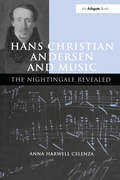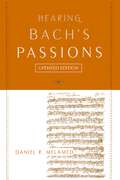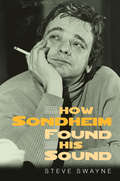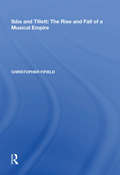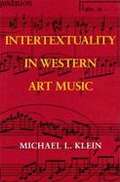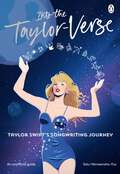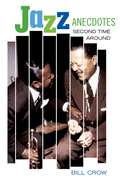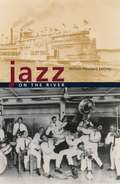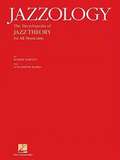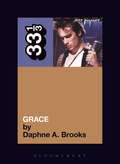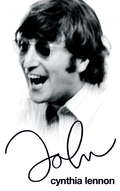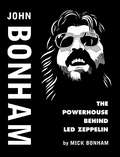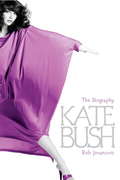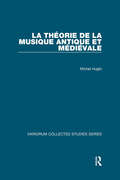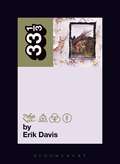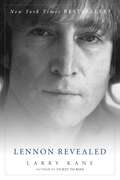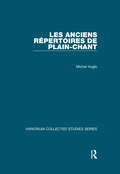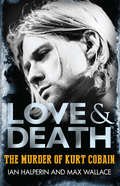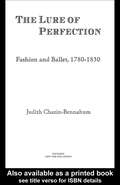- Table View
- List View
Hans Christian Andersen and Music: The Nightingale Revealed
by AnnaHarwell CelenzaHans Christian Andersen was the most prominent Danish author of the nineteenth century. Now known primarily for his fairy tales, during his lifetime he was equally famous for his novels, travelogues, poetry, and stage works, and it was through these genres that he most often reflected on the world around him. With the bicentennial of Andersen's birth in 2005, there is still much about the writer that is not yet common knowledge. This book explores a single aspect of that void - his interest in and relationship to the musical culture of nineteenth-century Europe. Why look to Andersen for information about music? To begin, Andersen had a musical background. He enjoyed a brief career as an opera singer and dancer at the Royal Theater in Copenhagen, and in later years he went on to produce opera libretti for the Danish and German stage. Andersen was also an avid music devotee. He made thirty major European tours during his seventy years, and on each of these trips he regularly attended opera and concert performances, recording his impressions in a series of travel diaries. In short, Andersen was a well-informed listener, and as this book reveals, his reflections on the music of his age serve as valuable sources for the study of music reception in the nineteenth century. Over the course of his life, Andersen embraced and then later rejected performers such as Maria Malibran, Franz Liszt, and Ole Bull, and his interest in opera and instrumental music underwent a series of dramatic transformations. In his final years, Andersen promoted figures as disparate as Wagner and Mendelssohn, while strongly objecting to Brahms. Although such changes in taste might be interpreted as indiscriminate by modern-day readers, this study shows that such shifts in opinion were not contradictory, but rather quite logical given the social and cultural climate of the age.
Hans Christian Andersen and Music: The Nightingale Revealed
by AnnaHarwell CelenzaHans Christian Andersen was the most prominent Danish author of the nineteenth century. Now known primarily for his fairy tales, during his lifetime he was equally famous for his novels, travelogues, poetry, and stage works, and it was through these genres that he most often reflected on the world around him. With the bicentennial of Andersen's birth in 2005, there is still much about the writer that is not yet common knowledge. This book explores a single aspect of that void - his interest in and relationship to the musical culture of nineteenth-century Europe. Why look to Andersen for information about music? To begin, Andersen had a musical background. He enjoyed a brief career as an opera singer and dancer at the Royal Theater in Copenhagen, and in later years he went on to produce opera libretti for the Danish and German stage. Andersen was also an avid music devotee. He made thirty major European tours during his seventy years, and on each of these trips he regularly attended opera and concert performances, recording his impressions in a series of travel diaries. In short, Andersen was a well-informed listener, and as this book reveals, his reflections on the music of his age serve as valuable sources for the study of music reception in the nineteenth century. Over the course of his life, Andersen embraced and then later rejected performers such as Maria Malibran, Franz Liszt, and Ole Bull, and his interest in opera and instrumental music underwent a series of dramatic transformations. In his final years, Andersen promoted figures as disparate as Wagner and Mendelssohn, while strongly objecting to Brahms. Although such changes in taste might be interpreted as indiscriminate by modern-day readers, this study shows that such shifts in opinion were not contradictory, but rather quite logical given the social and cultural climate of the age.
Hearing Bach's Passions
by Daniel R. MelamedJohann Sebastian Bach's two surviving passions--St. John and St. Matthew--are an essential part of the modern repertory, performed regularly both by professional ensembles and amateur groups. These large, complex pieces are well loved, but due to our distance from the original context in which they were performed, questions and problems emerge. Bach scholar Daniel Melamed examines the issues we encounter when we hear the passions performed today, and offers unique insight into Bach's passion settings. Rather than providing a movement-by-movement analysis, Melamed uses the Bach repertory to introduce readers to some of the intriguing issues in the study and performance of older music, and explores what it means to listen to this music today. For instance, Bach wrote the passions for a particular liturgical event at a specific time and place; we hear them hundreds of years later, often a world away and usually in concert performances. They were performed with vocal and instrumental forces deployed according to early 18th-century conceptions; we usually hear them now as the pinnacle of the choral/orchestral repertory, adapted to modern forces and conventions. In Bach's time, passion settings were revised, altered, and tampered with both by their composers and by other musicians who used them; today we tend to regard them as having fixed texts to be treated mith respect. Their music was sometimes recycled from other compositions or reused itself for other purposes; we have trouble imagining the familiar material of Bach's passion settings in any other guise. Melamed takes on these issues, exploring everything from the sources that transmit Bach's passion settings today to the issues surrounding performance practice (including the question of the size of Bach's ensemble). He delves into the passions as dramatic music, examines the problem of multiple versions of a work and the reconstruction of lost pieces, explores the other passions in Bach's performing repertory, and sifts through the puzzle of authorship. Highly accessible to the non-specialist, the book assumes no technical musical knowledge and does not rely on printed musical examples. Based on the most recent scholarship and using lucid prose, the book opens up the debates surrounding this repertory to music lovers, choral singers, church musicians, and students of Bach's music.
How Sondheim Found His Sound
by Steve Swayne"The research is voluminous, as is the artistry and perceptiveness. Swayne has lived richly within the world of Sondheim's music." ---Richard Crawford, author of America's Musical Life: A History "Sondheim's career and music have never been so skillfully dissected, examined, and put in context. With its focus on his work as composer, this book is surprising and welcome." ---Theodore S. Chapin, President and Executive Director, The Rodgers & Hammerstein Organization "What a fascinating book, full of insights large and small. An impressive analysis and summary of Sondheim's many sources of inspiration. All fans of the composer and lovers of Broadway in general will treasure and frequently refer to Swayne's work." ---Tom Riis, Joseph Negler Professor of Musicology and Director of the American Music Research Center, University of Colorado Stephen Sondheim has made it clear that he considers himself a "playwright in song." How he arrived at this unique appellation is the subject of How Sondheim Found His Sound---an absorbing study of the multitudinous influences on Sondheim's work. Taking Sondheim's own comments and music as a starting point, author Steve Swayne offers a biography of the artist's style, pulling aside the curtain on Sondheim's creative universe to reveal the many influences---from classical music to theater to film---that have established Sondheim as one of the greatest dramatic composers of the twentieth century. Sondheim has spoken often and freely about the music, theater, and films he likes, and on occasion has made explicit references to how past works crop up in his own work. He has also freely acknowledged his eclecticism, seeing in it neither a curse nor a blessing but a fact of his creative life. Among the many forces influencing his work, Sondheim has readily pointed to a wide field: classical music from 1850 to 1950; the songs of Tin Pan Alley, Broadway, and Hollywood; the theatrical innovations of Oscar Hammerstein II and his collaborators; the cinematic elements found in certain film schools; and the melodramatic style of particular plays and films. Ultimately, Sondheim found his sound by amalgamating these seemingly disparate components into his unique patois. How Sondheim Found His Sound is the first book to provide an overview of his style and one of only a few to account for these various components, how they appear in Sondheim's work, and how they affect his musical and dramatic choices.
Ibbs and Tillett: The Rise and Fall of a Musical Empire
by Christopher FifieldFor the greater part of the twentieth century, Ibbs and Tillett's concert agency was to the British music industry what Marks and Spencer is to the world of the department store. The roll-call of famous musicians on its books was unmatched, and included such international stars as Clara Butt, Fritz Kreisler, Pablo Casals, Sergei Rachmaninov, Andr Segovia, Kathleen Ferrier, Myra Hess, Jacqueline du Pr Clifford Curzon and Vladimir Ashkenazy, to name but a handful. From 1906, the success of the company was due to the dedication of its founders, Robert Leigh Ibbs and John Tillett. After their deaths, the agency was run by the latter's wife, Emmie, who, dubbed the 'Duchess of Wigmore Street', became one of the most formidable yet respected women in British music. The history of this unique institution and its owners is told here for the first time, often through the fascinating letters that were exchanged between the artists themselves and the agency. It begins in the latter years of the 19th century with the concert and theatrical manager Narciso Vert, for whom both Ibbs and Tillett worked until his death in 1905. The story then becomes a history of musical life in twentieth-century Britain, illuminating aspects of the day-to-day management of concerts and festivals, the lives and livelihoods of professional musicians, as well as those who strove to join their ranks through audition or recommendation. The changing profile, and particularly the onset and development of personal management of artists represented by Ibbs and Tillett and their reception in the press, can be viewed as a barometer of musical taste. The demise of the agency in 1990 was indicative of just how much the world of British music had changed by the end of the century, but despite its loss to the profession, the legacy and influence of Ibbs and Tillett has remained a benchmark in today's highly competitive world of artist management and concert promotion, many of whose principal operators began
Ibbs and Tillett: The Rise and Fall of a Musical Empire
by Christopher FifieldFor the greater part of the twentieth century, Ibbs and Tillett's concert agency was to the British music industry what Marks and Spencer is to the world of the department store. The roll-call of famous musicians on its books was unmatched, and included such international stars as Clara Butt, Fritz Kreisler, Pablo Casals, Sergei Rachmaninov, Andr Segovia, Kathleen Ferrier, Myra Hess, Jacqueline du Pr Clifford Curzon and Vladimir Ashkenazy, to name but a handful. From 1906, the success of the company was due to the dedication of its founders, Robert Leigh Ibbs and John Tillett. After their deaths, the agency was run by the latter's wife, Emmie, who, dubbed the 'Duchess of Wigmore Street', became one of the most formidable yet respected women in British music. The history of this unique institution and its owners is told here for the first time, often through the fascinating letters that were exchanged between the artists themselves and the agency. It begins in the latter years of the 19th century with the concert and theatrical manager Narciso Vert, for whom both Ibbs and Tillett worked until his death in 1905. The story then becomes a history of musical life in twentieth-century Britain, illuminating aspects of the day-to-day management of concerts and festivals, the lives and livelihoods of professional musicians, as well as those who strove to join their ranks through audition or recommendation. The changing profile, and particularly the onset and development of personal management of artists represented by Ibbs and Tillett and their reception in the press, can be viewed as a barometer of musical taste. The demise of the agency in 1990 was indicative of just how much the world of British music had changed by the end of the century, but despite its loss to the profession, the legacy and influence of Ibbs and Tillett has remained a benchmark in today's highly competitive world of artist management and concert promotion, many of whose principal operators began
Intertextuality in Western Art Music (PDF)
by Michael L. KleinThe outstanding originality of this book lies in the detail and perspicuity with which interrelations are traced between texts, it even seems that relations sometimes work backwards. Above all, this book does not offer a ‘theory of intertextuality.’ Rather, it is a many-sided survey of the topic, open-ended and truthful. It is fresh and inspirational." ―Raymond Monelle, Reader in Music at the University of Edinburgh and author of Linguistics and Semiotics in Music Intertextuality in Western Art Music provides an interdisciplinary approach to the questions of music and meaning, using the approaches of Barthes, Foucault, Eco, Derrida, Lévi-Strauss, and others. Drawing on research in aesthetics, hermeneutics, semiotics, narrativity, analysis, and musicology, Klein argues that each musical text is part of a cultural network of texts that code the ways we make sense of music.
Into the Taylor-Verse: A tour of Taylor Swift's songwriting journey through the eras
by Satu Hämeenaho-FoxFearlessly jump and fall into the world of Taylor Swift with this illustrated appreciation of her music by Swiftian Theory co-founder Satu Hämeenaho-Fox.This is the book for all Swifties of every era, and the perfect gift for the Taylor Swift fan in your life.Get ready to deep dive into the story of Taylor’s life through her songwriting. Travel back to where it all began with her debut album Taylor Swift and journey through the eras, from the enchanting moments of Speak Now and 1989's red-heart sunglasses, to the cosy cardigan's of Folklore and bejewelled Midnights.Including the musical influences and personal experiences that helped make Taylor the mastermind and icon she is, this book celebrates the inimitable talent of one of the world’s greatest songwriters, performers and cat lovers.Covering her groundbreaking tours, fiercely loyal fans and inspiring position as a businesswoman, discover how Taylor uses her signature themes of girlhood, heartbreak and female friendship to master her craft, and how her genius for poignant lyrics and planting secret clues has developed her music into a whole universe for Swifties to explore.Are you ready for it?
Jazz Anecdotes: Second Time Around
by Bill CrowWhen jazz musicians get together, they often delight one another with stories about the great, or merely remarkable, players and singers they've worked with. One good story leads to another until someone says, "Somebody ought to wrie these down!" With Jazz Anecdotes, somebody finally has. Drawing on a rich verbal tradition, bassist and jazz writer Bill Crow has culled stories from a wide variety of sources, including interviews, biographies and a remarkable oral history collection, which resides at the Institute of Jazz Studies at Rutgers University, to paint fascinating and very human portraits of jazz musicians. Organized around general topics--teaching and learning, life on the road, prejudice and discrimination, and the importance of a good nickname--Jazz Anecdotes shows the jazz world as it really is. In this fully updated edition, which contains over 150 new anecdotes and new topics like Hiring and Firing, Crow regales us with new stories of such jazz greats as Benny Goodman, Chet Baker, Ravi Coltrane, Buddy Rich and Paul Desmond. He offers extended sections on old favorites--Louis Armstrong, Duke Ellington, Coleman Hawkins and Lester Young, and the fabulous Eddie Condon, who seems to have lived his entire life with the anecdotist in mind. With its unique blend of sparkling dialogue and historical and social insight, Jazz Anecdotes will delight anyone who loves a good story. It offers a fresh perspective on the joys and hardships of a musician's life as well as a rare glimpse of the personalities who created America's most distinctive music.
Jazz on the River (Science And Its Conceptual Foundations Ser.)
by William Howland KenneyJust after World War I, the musical style called jazz began a waterborne journey outward from that quintessential haven of romance and decadence, New Orleans. For the first time in any organized way, steam-driven boats left town during the summer months to tramp the Mississippi River, bringing an exotic new music to the rest of the nation. For entrepreneurs promoting jazz, this seemed a promising way to spread northward the exciting sounds of the Crescent City. And the musicians no longer had to wait for folks upriver to make their way down to New Orleans to hear the vibrant rhythms, astonishing improvisations, and new harmonic idioms being created. Simply put, when jazz went upstream, it went mainstream, and in Jazz on the River, William Howland Kenney brings to life the vibrant history of this music and its seduction of the men and women along America's inland waterways. Here for the first time readers can learn about the lives and music of the levee roustabouts promoting riverboat jazz and their relationships with such great early jazz adventurers as Louis Armstrong, Fate Marable, Warren "Baby" Dodds, and Jess Stacy. Kenney follows the boats from Memphis to St. Louis, where new styles of jazz were soon produced, all the way up the Ohio River, where the music captivated audiences in Cincinnati and Pittsburgh alike. Jazz on the River concludes with the story of the decline of the old paddle wheelers-and thus riverboat jazz-on the inland waterways after World War II. The enduring silence of our rivers, Kenney argues, reminds us of the loss of such a distinctive musical tradition. But riverboat jazz still lives on in myriad permutations, each one in tune with our own times.
Jazzology: The Encyclopedia of Jazz Theory for all Musicians (PDF) (Jazz Instruction Ser.)
by Robert Rawlins Nor Eddine BahhaA one-of-a-kind book encompassing a wide scope of jazz topics, for beginners and pros of any instrument. A three-pronged approach was envisioned with the creation of this comprehensive resource: as an encyclopedia for ready reference, as a thorough methodology for the student, and as a workbook for the classroom, complete with ample exercises and conceptual discussion. Includes the basics of intervals, jazz harmony, scales and modes, ii-V-I cadences. For harmony, it covers: harmonic analysis, piano voicings and voice leading; modulations and modal interchange, and reharmonization. For performance, it takes players through: jazz piano comping, jazz tune forms, arranging techniques, improvisation, traditional jazz fundamentals, practice techniques, and much more!
Jeff Buckley's Grace (33 1/3)
by Daphne A. BrooksThe power and influence of Grace increases with each passing year. Here, Daphne Brooks traces Jeff Buckley's fascinating musical development through the earliest stages of his career, up to the release of the album. With access to rare archival material, Brooks illustrates Buckley's passion for life and hunger for musical knowledge, and shows just why he was such a crucial figure in the American music scene of the 1990s.EXCERPT:Jeff Buckley was piecing together a contemporary popular music history for himself that was steeped in the magic of singing. He was busy hearing how Dylan channeled Billie Holiday in Blonde On Blonde and how Robert Plant was doing his best to sound like Janis Joplin on early Led Zeppelin recordings. He was thinking about doo-wop and opera and Elton John and working at developing a way to harness the power of the voice...In the process, he was re-defining punk and grunge "attitude" itself by rejecting the ambivalent sexual undercurrents of those movements, as well as Led Zeppelin's canonical "cock rock" kingdom that he'd grown up adoring. He was forging a one-man revolution set to the rhythms of New York City and beyond. And he was on the brink of recording his elegant battle in song for the world to hear.
John: A Biography
by Cynthia LennonCynthia and John Lennon's relationship spanned ten crucial years of the Beatles phenomenon. But as well as new insight into the Beatles years, Cynthia has a compelling personal story of marriage, motherhood and the man who was to become the most idolised and admired of all the Beatles.Cynthia is candid about the cruel and the loving sides of John. She tells of the end of their marriage and the beginning of his relationship with Yoko Ono in more detail than ever before, and reveals the many difficulties estrangement from John - and then his death - brought for herself and Julian. Cynthia is a remarkable survivor and this is her extraordinary story and unique insight into a man loved and idolised all over the world.
John Bonham: The Powerhouse behind Led Zeppelin
by Mick BonhamBonham is a complete portrait of the drummers' drummer written by his brother Mick Bonham. With exclusive interviews and previously un-published photos from the Bonham collection, as well as a complete Led Zeppelin chronology and history of Bonham's earlier musical career.
Kate Bush: The biography (Tom Thorne Novels #169)
by Rob JovanovicKate Bush has written some of the most memorable songs in pop music history. Wuthering Heights, her debut single shot to number 1 in 1978 and she remains something of an enigma over a quarter of a century later. A singer, songwriter, musician, dancer, actress and director, Kate has inspired a devoted following around the world. Rob Jovanovic traces the story of Kate Bush's career, from her up-bringing in the Essex countryside through her first forays into music with a series of home recordings, to her number 1 debut album that propelled her to international stardom. Including exclusive interviews with studio musicians and choreographers, Jovanovic's biography emphasises both her voracious talent and her intensely private personality.
La théorie de la musique antique et médiévale
by Michel HugloThis is the final volume in the set of four collections of Michel Huglo's articles to be published in the Variorum series, and focuses on medieval music theory. The point of departure for Huglo's research was his doctoral dissertation on tonaries, published in 1971: as a consequence, he studied the manuscripts of music theory concerning plainchant, and, later, those with writings on music by authors of Late Antiquity as well as the Liber glossarum, with its many definitions of musical terms. In this volume, certain articles consider the interpretation or dissemination of texts, instruction in the art of plainchant, and musical instruction at the university. Others concern the manuscripts of St Augustine's De musica and of the writings of Calcidius, Macrobius, Helisachar, Hucbald, Gerbert of Aurillac, Abbo of Fleury, John of Afflighem, and Hieronymus de Moravia, amongst others. The volume closes with a bibliography of Michel Huglo complementing that published in 1993 and a summary list of his reviews of books on music and liturgy. Ce volume des articles de Michel Huglo termine la série de quatre dans la collection Variorum. Il est centré sur la théorie musicale médiévale. Le point de départ des recherches de Michel Huglo sur la théorie musicale du Moyen Âge est formé par sa thèse sur les tonaires, éditée en 1971: en consequence il etudia les manuscrits de theorie musicale concernant le plain-chant et, plus tard, les auteurs de l'Antiquité tardive et le Liber glossarum qui contient des définitions de nombreux termes musicaux. Dans ce volume, certains articles traitent de l'interprétation ou de la dissémination des textes, des instructions sur l'art du chant, et sur l'enseignement de la musique à l'Université. Ils concernent les manuscrits du De musica d'Augustin, de Calcidius, Macrobe, Helisachar, Hucbald, Gerbert d'Aurillac, Abbon de Fleury, Jean d'Afflighem, Hieronymus de Moravia, et d'autres auteurs. Le volume se termine par une bibliographie de Michel Huglo complétant celle publiée en 1993 et une liste sommaire de ses recensions d'ouvrages sur la musique et la liturgie.
La théorie de la musique antique et médiévale
by Michel HugloThis is the final volume in the set of four collections of Michel Huglo's articles to be published in the Variorum series, and focuses on medieval music theory. The point of departure for Huglo's research was his doctoral dissertation on tonaries, published in 1971: as a consequence, he studied the manuscripts of music theory concerning plainchant, and, later, those with writings on music by authors of Late Antiquity as well as the Liber glossarum, with its many definitions of musical terms. In this volume, certain articles consider the interpretation or dissemination of texts, instruction in the art of plainchant, and musical instruction at the university. Others concern the manuscripts of St Augustine's De musica and of the writings of Calcidius, Macrobius, Helisachar, Hucbald, Gerbert of Aurillac, Abbo of Fleury, John of Afflighem, and Hieronymus de Moravia, amongst others. The volume closes with a bibliography of Michel Huglo complementing that published in 1993 and a summary list of his reviews of books on music and liturgy. Ce volume des articles de Michel Huglo termine la série de quatre dans la collection Variorum. Il est centré sur la théorie musicale médiévale. Le point de départ des recherches de Michel Huglo sur la théorie musicale du Moyen Âge est formé par sa thèse sur les tonaires, éditée en 1971: en consequence il etudia les manuscrits de theorie musicale concernant le plain-chant et, plus tard, les auteurs de l'Antiquité tardive et le Liber glossarum qui contient des définitions de nombreux termes musicaux. Dans ce volume, certains articles traitent de l'interprétation ou de la dissémination des textes, des instructions sur l'art du chant, et sur l'enseignement de la musique à l'Université. Ils concernent les manuscrits du De musica d'Augustin, de Calcidius, Macrobe, Helisachar, Hucbald, Gerbert d'Aurillac, Abbon de Fleury, Jean d'Afflighem, Hieronymus de Moravia, et d'autres auteurs. Le volume se termine par une bibliographie de Michel Huglo complétant celle publiée en 1993 et une liste sommaire de ses recensions d'ouvrages sur la musique et la liturgie.
Led Zeppelin's Led Zeppelin IV (33 1/3)
by Erik DavisIn this wickedly entertaining and thoroughly informed homage to one of rock music's towering pinnacles, Erik Davis investigates the magic-black or otherwise-that surrounds this album. Carefully peeling the layers from each song, Davis reveals their dark and often mystical roots-and leaves the reader to decide whether [FOUR SYMBOLS] is some form of occult induction or just an inspired, brilliantly played rock album.Excerpt:Stripping Led Zeppelin's famous name off the fourth record was an almost petulant attempt to let their Great Work symbolically stand on its own two feet. But the wordless jacket also lent the album charisma. Fans hunted for hidden meanings, or, in failing to find them, sensed a strange reflection of their own mute refusal to communicate with the outside world. This helped to create one of the supreme paradoxes of rock history: an esoteric megahit, a blockbuster arcanum. Stripped of words and numbers, the album no longer referred to anything but itself: a concrete talisman that drew you into its world, into the frame. All the stopgap titles we throw at the thing are lame: Led Zeppelin IV, [Untitled], Runes, Zoso, Four Symbols. In an almost Lovecraftian sense, the album was nameless, a thing from beyond, charged with manna. And yet this uncanny fetish was about as easy to buy as a jockstrap.
Lennon Revealed
by Larry KaneA quarter of a century after his death, the questions remain: what was John Lennon really like, what drove him to the heights of creativity and the depths of despair, and why do his music and message still resonate for millions around the world? Now acclaimed broadcast journalist and author Larry Kane uncovers the mysteries of Lennon's life and implodes the myths surrounding it. Kane definitely has the right credentials for the job. He was the only American reporter to travel in the Beatles' official entourage to every stop on their history-making first American tours, and he stayed in touch with Lennon until an assassin ended the former Beatles' life in 1980. Lennon Revealed is filled with revelations about John Lennon's path from public glory to personal crisis, and ultimately to his inspiring rebirth and the triumph of his spirit. Drawing on extensive personal accounts and extraordinary new interviews with more than 100 confidants-most notably, Yoko Ono-Kane presents stunning revelations and brings the reader closer than ever to the man who, in life and in death, has had an incalculable impact on humanity. Includes an exclusive DVD featuring the final interview with Lennon and Paul McCartney, conducted by Larry Kane.
Lennon Revealed
by Larry KaneA quarter of a century after his death, the questions remain: what was John Lennon really like, what drove him to the heights of creativity and the depths of despair, and why do his music and message still resonate for millions around the world? Now acclaimed broadcast journalist and author Larry Kane uncovers the mysteries of Lennon's life and implodes the myths surrounding it. Kane definitely has the right credentials for the job. He was the only American reporter to travel in the Beatles' official entourage to every stop on their history-making first American tours, and he stayed in touch with Lennon until an assassin ended the former Beatles' life in 1980. Lennon Revealed is filled with revelations about John Lennon's path from public glory to personal crisis, and ultimately to his inspiring rebirth and the triumph of his spirit. Drawing on extensive personal accounts and extraordinary new interviews with more than 100 confidants-most notably, Yoko Ono-Kane presents stunning revelations and brings the reader closer than ever to the man who, in life and in death, has had an incalculable impact on humanity. Includes an exclusive DVD featuring the final interview with Lennon and Paul McCartney, conducted by Larry Kane.
Les anciens répertoires de plain-chant
by Michel HugloThe differences between Old-Roman, Ambrosian, Aquileian, Gallican, and Hispanic chant, and their interconnections with each other and the Gregorian chant occupied Michel Huglo in his early career, although he returned to these questions in the 1980s and 1990s. The present volume, the second in the set of four to be published in the Variorum series, brings all this work together. Huglo's 1954 article, the first to describe the sources for Old Roman chant, recognized as distinct from Gregorian chant, is of primary significance for the historiography of Western plainchant, because it opened the debate on the relationship between Old Roman and Gregorian chant. The final section presents articles on the Latin version of the Akathistos hymn and on Byzantine chants translated into Latin that became part of the Western plainchant repertory. Les différences entre les répertoires Vieux-romain, Ambrosien, Aquiléien, Gallican et Hispanique, leurs influences réciproques et leurs relations avec le chant grégorien ont occupé Michel Huglo au début de sa carrière: il revint sur ces questions dans les années 1980 et 1990. Ce volume, le deuxième d'une série de quatre dans la collection Variorum, réunit toutes ces études. L'article de 1954 de Michel Huglo sur les sources du chant Vieux-romain, considéré comme distinct du grégorien, est de première importance pour l'historiographie du plain-chant occidental, car il a ouvert les débats sur le rapport entre Vieux-romain et grégorien. Les articles sur la version latine de l'Hymne Acathiste et sur les pièces de chant byzantin traduites en latin dans les répertoires occidentaux du plain-chant achèvent ce volume.
Les anciens répertoires de plain-chant
by Michel HugloThe differences between Old-Roman, Ambrosian, Aquileian, Gallican, and Hispanic chant, and their interconnections with each other and the Gregorian chant occupied Michel Huglo in his early career, although he returned to these questions in the 1980s and 1990s. The present volume, the second in the set of four to be published in the Variorum series, brings all this work together. Huglo's 1954 article, the first to describe the sources for Old Roman chant, recognized as distinct from Gregorian chant, is of primary significance for the historiography of Western plainchant, because it opened the debate on the relationship between Old Roman and Gregorian chant. The final section presents articles on the Latin version of the Akathistos hymn and on Byzantine chants translated into Latin that became part of the Western plainchant repertory. Les différences entre les répertoires Vieux-romain, Ambrosien, Aquiléien, Gallican et Hispanique, leurs influences réciproques et leurs relations avec le chant grégorien ont occupé Michel Huglo au début de sa carrière: il revint sur ces questions dans les années 1980 et 1990. Ce volume, le deuxième d'une série de quatre dans la collection Variorum, réunit toutes ces études. L'article de 1954 de Michel Huglo sur les sources du chant Vieux-romain, considéré comme distinct du grégorien, est de première importance pour l'historiographie du plain-chant occidental, car il a ouvert les débats sur le rapport entre Vieux-romain et grégorien. Les articles sur la version latine de l'Hymne Acathiste et sur les pièces de chant byzantin traduites en latin dans les répertoires occidentaux du plain-chant achèvent ce volume.
Love & Death: The Murder of Kurt Cobain
by Max WallaceTHE EXPLOSIVE INVESTIGATION INTO THE DEATH OF KURT COBAIN.Friday, 8th April 1994. Kurt Cobain’s body was discovered in a room above a garage in Seattle. For the attending authorities, it was an open-and-shut case of suicide. What no one knew was Cobain had been murdered.That April, Cobain went missing for several days, or so it seemed: in fact, some people knew where he was, and one of them was Courtney Love. This explosive crusade for the truth paints a critical portrait of Love, and reveals for the first time the case tapes made by Love’s own private investigator who was on a mission to find the truth about Cobain’s death.
The Lure of Perfection: Fashion and Ballet, 1780-1830
by Judith BennahumTHE LURE OF PERFECTION: FASHION AND BALLET, 1780-1830 offers a unique look at how ballet influenced contemporary fashion and women's body image, and how street fashions in turn were reflected by the costumes worn by ballet dancers. Through years of research, the author has traced the interplay between fashion, social trends, and the development of dance. During the 18th century, women literally took up twice as much space as men; their billowing dresses ballooned out from their figures, sometimes a full 55 inches, to display costly jewelry and fine brocade work; similar costumes appeared on stage. But clothing also limited her movement; it literally disabled them, making the dances themselves little more than tableaux. Movement was further inhibited by high shoes and tight corsets; thus the image of the rigidly straight, long-lined dancer is as much a product of clothing as aesthetics. However, with changing times came new trends. An increased interest in natural movement and the common folk led to less-restrictive clothing. As viewers demanded more virtuosic dancers, women literally danced their way to freedom. THE LURE OF PERFECTION will interest students of dance and cultural history, and women's studies. It is a fascinating, well-researched look at the interplay of fashion, dance, and culture-still very much a part of our world today.
The Lure of Perfection: Fashion and Ballet, 1780-1830
by Judith BennahumTHE LURE OF PERFECTION: FASHION AND BALLET, 1780-1830 offers a unique look at how ballet influenced contemporary fashion and women's body image, and how street fashions in turn were reflected by the costumes worn by ballet dancers. Through years of research, the author has traced the interplay between fashion, social trends, and the development of dance. During the 18th century, women literally took up twice as much space as men; their billowing dresses ballooned out from their figures, sometimes a full 55 inches, to display costly jewelry and fine brocade work; similar costumes appeared on stage. But clothing also limited her movement; it literally disabled them, making the dances themselves little more than tableaux. Movement was further inhibited by high shoes and tight corsets; thus the image of the rigidly straight, long-lined dancer is as much a product of clothing as aesthetics. However, with changing times came new trends. An increased interest in natural movement and the common folk led to less-restrictive clothing. As viewers demanded more virtuosic dancers, women literally danced their way to freedom. THE LURE OF PERFECTION will interest students of dance and cultural history, and women's studies. It is a fascinating, well-researched look at the interplay of fashion, dance, and culture-still very much a part of our world today.
